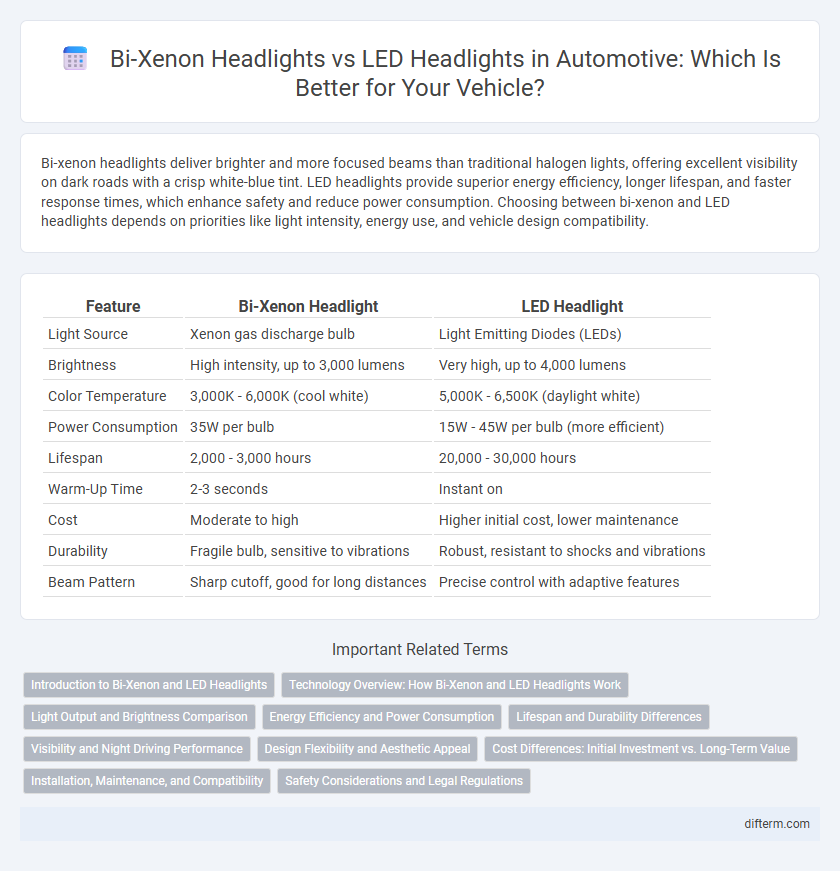Bi-xenon headlights deliver brighter and more focused beams than traditional halogen lights, offering excellent visibility on dark roads with a crisp white-blue tint. LED headlights provide superior energy efficiency, longer lifespan, and faster response times, which enhance safety and reduce power consumption. Choosing between bi-xenon and LED headlights depends on priorities like light intensity, energy use, and vehicle design compatibility.
Table of Comparison
| Feature | Bi-Xenon Headlight | LED Headlight |
|---|---|---|
| Light Source | Xenon gas discharge bulb | Light Emitting Diodes (LEDs) |
| Brightness | High intensity, up to 3,000 lumens | Very high, up to 4,000 lumens |
| Color Temperature | 3,000K - 6,000K (cool white) | 5,000K - 6,500K (daylight white) |
| Power Consumption | 35W per bulb | 15W - 45W per bulb (more efficient) |
| Lifespan | 2,000 - 3,000 hours | 20,000 - 30,000 hours |
| Warm-Up Time | 2-3 seconds | Instant on |
| Cost | Moderate to high | Higher initial cost, lower maintenance |
| Durability | Fragile bulb, sensitive to vibrations | Robust, resistant to shocks and vibrations |
| Beam Pattern | Sharp cutoff, good for long distances | Precise control with adaptive features |
Introduction to Bi-Xenon and LED Headlights
Bi-xenon headlights utilize xenon gas and an electrical arc to produce a bright, intense light that offers improved visibility compared to traditional halogen lamps. LED headlights employ light-emitting diodes to deliver energy-efficient illumination with longer lifespan and faster response times. Both technologies enhance nighttime driving safety, but differ significantly in light quality, power consumption, and durability.
Technology Overview: How Bi-Xenon and LED Headlights Work
Bi-xenon headlights utilize high-intensity discharge (HID) technology, producing light by igniting xenon gas with an electrical arc, which generates a bright, white beam with excellent range and brightness. LED headlights operate through semiconductor diodes that emit light when an electrical current passes through, offering energy efficiency, faster response times, and longer lifespan compared to HID bulbs. Both technologies contribute to improved road visibility and safety, with bi-xenon focusing on intense beam output and LED emphasizing durability and energy savings.
Light Output and Brightness Comparison
Bi-xenon headlights produce a bright, high-intensity light with a color temperature typically around 4300K, providing excellent long-distance illumination and strong penetration through fog and rain. LED headlights offer higher luminous efficacy, with brightness often exceeding 3000 lumens per bulb, delivering a more uniform and focused beam pattern that consumes less power. Comparatively, LED headlights provide superior light output consistency and longevity, while bi-xenon lights excel in producing intense, wide beams suitable for faster driving conditions.
Energy Efficiency and Power Consumption
Bi-xenon headlights typically consume around 35 watts of power, offering a bright and focused beam but with moderate energy efficiency compared to LED headlights. LED headlights operate at significantly lower power levels, usually between 15 to 20 watts, delivering comparable or superior luminance while reducing overall energy consumption. The enhanced efficiency of LED technology contributes to improved fuel economy and lower electrical load on automotive systems, making it a preferable choice for energy-conscious vehicle designs.
Lifespan and Durability Differences
Bi-xenon headlights typically last around 2,000 to 3,000 hours, offering strong brightness but shorter lifespan compared to LED headlights, which can endure up to 30,000 to 50,000 hours due to solid-state technology. LED headlights exhibit higher durability, resisting vibration and shock better, making them ideal for rugged driving conditions. The extended lifespan and robust build of LEDs reduce maintenance frequency and replacement costs compared to bi-xenon systems.
Visibility and Night Driving Performance
Bi-xenon headlights emit a bright, white light with a longer range, enhancing visibility by reducing glare and improving contrast on dark roads. LED headlights offer sharper, more uniform illumination with faster response times and lower energy consumption, providing superior clarity in various weather conditions. Both technologies improve night driving performance, but LEDs deliver more consistent light output and adaptive beam control for increased safety.
Design Flexibility and Aesthetic Appeal
Bi-xenon headlights offer limited design flexibility due to their larger projector units, which constrain sleek and compact headlamp shapes. LED headlights provide superior aesthetic appeal with their ability to be shaped into intricate, slim designs that integrate seamlessly into modern vehicle styling. Advanced LED technology allows for customizable light patterns and color temperatures, enhancing both functionality and visual impact.
Cost Differences: Initial Investment vs. Long-Term Value
Bi-xenon headlights generally have a lower initial purchase cost compared to LED headlights, making them a budget-friendly option for many drivers. However, LED headlights offer superior energy efficiency and longer lifespan, which translates to reduced maintenance and replacement expenses over time. Evaluating the total cost of ownership reveals that LEDs provide greater long-term value despite their higher upfront price.
Installation, Maintenance, and Compatibility
Bi-xenon headlights require ballasts and igniters for installation, complicating the process compared to LED headlights, which often feature plug-and-play systems for easier fitting. Maintenance for bi-xenon units involves periodic bulb replacements and ballast inspections due to their high-voltage components, whereas LED headlights offer longer lifespans with minimal upkeep. Compatibility considerations favor LED headlights, as they integrate seamlessly with modern vehicle electronics and support advanced features like adaptive lighting, while bi-xenon systems may require specific housings and modifications for optimal performance.
Safety Considerations and Legal Regulations
Bi-xenon headlights provide intense, focused illumination improving night visibility but may cause glare if not properly aligned, impacting safety and compliance with regulations such as UNECE R98. LED headlights offer energy-efficient, uniform light distribution with faster activation, reducing reaction time and enhancing pedestrian safety under standards like FMVSS 108. Both lighting types must meet specific legal requirements concerning beam pattern, brightness, and color temperature to ensure road safety and avoid penalties.
Bi-xenon headlight vs LED headlight Infographic

 difterm.com
difterm.com